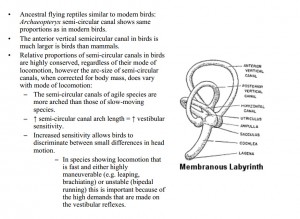Mercedes-Benz recently released a new commercial in which several chickens are rolled and moved about by anonymous human arms. The point of the commercial is to demonstrate the fact that a chicken’s head is incredibly stable despite its body’s movements (and then liken their automobile’s stabilization to a chicken’s stable head). This physical attribute gives chickens the appearance of having “steady-camera” head.
This past week, several blogs and news sites reported on this unique and hilarious chicken commercial. However, none of these articles actually really discuss why chickens’ heads behave in this manner. I was dissatisfied with these blog posts and news stories and so I did a little research on the subject. I share what I learned through this research with you on today’s show.
Here is the Mercedes-Benz chicken commercial
Before I get started I need to provide you, the audience, a disclaimer. I am not a doctor – nor do I play one on television. I am in no-way connected to the medical field. What I am going to share with you herein is all that I was able to learn as a layperson. Take the following information as you will.
The Human Vestibulo Ocular Reflex
To understand why the chicken is what it is – we must first understand how our own human physiology works. Humans are blessed with a physiological system called the vestibular system. The vestibular system is a sophisticated internal system that links the eyes with the inner ear and allows for clear vision while your body is moving.
The human eye acts like a tiny camera obscura. Like a camera, light enters into your eye through your cornea that dilates (i.e. opens or closes, much like the aperture of a traditional camera) to control how much light is allow to enter into the eye. This light is then focused on the back of the eye, which is the retina. The image that is focused on the retina is then transmitted to the brain (this is how you can see). As amazing and glorious as the human eye is – the retina cannot instantly refocus an image which is being moved. If you shake your camera while snapping a photograph you end up with an out of focus picture. Your retinas are the same – if the eyes are not stable, you get a blurry picture in your head.
Humans are moving creatures. We need to be able to move and see clearly at the same time. In order to compensate for this shortcoming in the eye, the human body has the vestibular system. The vestibular system is a set of reflexes which steadies the human eye position when the head and body are moving. The vestibular reflex system is commonly referred to as the vestibulo ocular reflex (“VOR”). The VOR is actually a complex connection between your inner ear and certain muscles in your eyes.
There are three organs in your inner ear that register the roll, yaw and pitch in the movement of your head and body. If you are unfamiliar with these terms (roll, yaw and pitch), please refer to the link (HERE) which shows an airplane demonstrating roll, yaw and pitch. The three inner ear organs that detect motion (i.e. roll, pitch and yaw), are the semi-circular canals, the utricle and the saccule.
The semi-circular canals are actually three tubes positioned at different angles and filled with a liquid inside. When your head moves, the fluid inside these canals shifts and disturbs tiny hair cells. This disturbance to the tiny hair cells triggers the VOR. Two of the three semi-circular canals detect the pitch movement. Pitch is the movement of the head up and down (like shaking your head “YES”). The third semi-circular canal detects yaw. Yaw is the horizontal movement of the head (like shaking your head “NO.”)
Short Video that explains how the inner ear is connected to the VOR
The utricle and saccule are a little different than the semi-circular canals. The utricle and saccule are not shaped like a like long narrow tubes. Instead, the utricle and saccule are small chambers. In these chambers are either a gel like substance or small calcium carbonate crystals. When your head tilts in a roll motion (imagine you were moving your head back and forth trying to touch your ears to the top of your shoulders), or if your body is moved vertically (e.g. when you’re in an elevator), or your body is moved horizontally (e.g. when you’re on a train) – the gel and little calcium carbonate crystals move in the utricle and saccule chambers. The shifting of the gel/calcium carbonate crystals in the utricle and saccule disturbs the tiny hair cell contained therein and causes the VOR to be triggered.
The semi-circular canals, the utricle and the saccule are each linked up with certain nerves which control different eye muscles. So when the inner ear detects motion, the VOR is triggered and a message is transmitted through the nerves to control the eye muscles and thus the eye movement. If you shake your head “No” (in a yaw motion), the VOR actually controls your eyes to move in the opposite direction than how your head is turning.
Awesome 1980’s video demonstrating horizontal VOR
VOR Experiment to Try on Yourself
Here is an experiment that you can try to see the VOR system at work in your own body. Take a piece of paper with writing on it and fix your eyes upon a particular word or phrase on the page. Now shake your head in a pitch direction, then in a yaw direction and finally in a roll direction while still focusing on the word/phrase on the page. You will see that amazingly your VOR system activates your eye muscles to move in opposite of your head motion, which allows you to continue to focus on the writing on the page.
Now try the second half of the experiment. Take that same page and focus again on a word or phrase written on the sheet before you. This time keep your head still but move the paper in a pitch, yaw and roll direction. You will find that your eyes are not able to remain focused on the word/phrase on the page as your VOR system is not activated. You experience visual blur because your retinas cannot take a focused “picture” of the page.
Chickens VOR and Steady-Cam Head
Let’s now consider the differences between chickens and humans on this topic. Most notably human and bird eyes are quite dissimilar. First, birds have a much bigger eyes to skull ratio than humans. A human’s eyes take up about 5% of his skull’s cavity space – bird’s eyes occupy about 50% of the bird’s skull cavity. The orientation of the eyes on the skull is much different on a chicken than a human. Lastly, a chicken’s eyes are not designed to roll around in its head like a marble in a socket, like a human’s eyes are. Consequently, bird eyes work somewhat differently than human eyes.
Chickens, like all birds, have a VOR system that is very similar to humans. Like humans they have the same three organs in their inner ears. Additionally, chickens, through the same inner ear organs can detect pitch, yaw and roll, as well as, sense vertical and horizontal movement.
Movement in a chicken’s body triggers the VOR system and the chicken’s inner ear organs send messages through the nerve system to help keep the chicken’s eyes in focus. However, chickens do not solely rely on their VOR system to see clearly. Rather, birds (like chickens) use their vestibulo collic reflex system (“VCR”). The vestibulo collic reflex controls the chicken’s posture when its body is moved. In chickens, the VCR particularly controls neck and head muscles to stabilize their vision. Consequently, chickens compensate for the limitations in their VOR system through the inner ear organs triggering their VCR system.
The result is that a bird stabilizes its vision when its body is in motion by activating its neck and head muscles to keep it’s head still. This head stability (and thus eyes stability) allows for chickens to clearly focus on a object even when their bodies are in motion. Consequently, chickens have “steady-cam” heads and humans don’t.
Video demonstrating a chicken’s VOR and VCR systems are work
There have been two different guys on you tube who have tried experimenting with a chicken’s “steady-cam” head by strapping a miniature video camera to a rooster’s comb and filming how steady the picture is of what he sees. These experiment videos are well worth a watch – very amusing!
Video of a Home Experiment Testing A Chicken’s Steady Cam Head
Here is the other guy’s chicken steady camera experiment – I love his “why not try it” attitude!
Video of the other Chicken Steady Camera Experiment
CHICKEN NEWS:
- Force Change-USDA cuts inspectors 40% -supports chicken chemical baths LINK
- Food Safety News – US parents angered over Chinese processed chicken coming soon to school lunches ARTICLE
MAIN SEGMENT:
- Science Journal – The Dizzy Patient: Disturbances of the Vestibular System LINK
- Scholarpedia – Vestibular System science ARTICLE
- Science Direct – Science journal article on avian vision LINK
- Diagrams and explanations of VOR in various species LINK
- NPR – Life’s a Smoother Ride If You’re a Chicken ARTICLE
- OSM – Weak attempt to explain VOR system in a chicken LINK
- Endgadget – Chicken Head Stabilization ARTICLE
- Experiment of Chicken steady cam v. kid steady cam VIDEO
- Another demonstration of a chicken’s VOR and VCR VIDEO
SALLY’S SIDENOTE:
- Chicken Calendar of Events – adding all U.S. poultry shows LINK
Podcast: Play in new window | Download | Embed
Subscribe: Apple Podcasts | RSS



